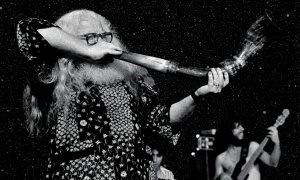Home » Jazz Articles » From the Inside Out » Nina Simone Speaks Like a River
Nina Simone Speaks Like a River
~ Nina Simone, DownBeat interview, 1969
With the January 17 unveiling of several titles from her back catalog, re-mastered and re-annotated and supplemented with bonus tracks, plus The Soul of Nina Simone CD / DVD dual disc released this past September, the music industry may be beginning to figure out the business of the uniquely talented Nina Simone.
From humble roots in her 1933 rural birthplace of Tryon, North Carolina, Simone grew to be a Julliard-trained classical pianist. Ultimately faced with the limited professional prospects the times would present to a female, black classical pianist, she learned to accompany her playing with singing. In the 1960s, Simone stood among the first musicians to use their craft to openly address issues of sexual and racial equality. In an 1961 interview with The New York Post, she said, "When I was a child, nobody was ever proud of me, and my people were never proud of themselves - or anything they'd ever done. Well, that's different now, I'm proud of myself and I'm proud of my music.
"Nina Simone emerged from the turbulent '60s as the fiery 'High Priestess of Soul,' writes Laura Shallop in the newly updated version of Silk and Soul, "A triple threat - singer, composer and pianist - she was the embodiment of the combustible diva.
As a composer, pianist and singer, Simone stands in the rare company of other "triple threats of her era: Ray Charles and Stevie Wonder most readily come to mind; Little Richard and Fats Domino, maybe, but that's about it.
(By the way, the state of North Carolina has given us three of most imposing, controversial and enduring personalities in jazz: Simone, Thelonious Monk, and John Coltrane. Is there some magic in that state's rolling hills and fertile fields?)
Simone recorded for RCA Records from 1966 to 1974, releasing nine albums and one of her most successful singles, "To Be Young, Gifted and Black. In 1966, the Congress for Racial Equality declared this song of hopeful encouragement, co-written with keyboard player Weldon Irvine, to be "The Black National Anthem.
It must have seemed perfectly reasonably to market Simone to the rock n' roll / youth market in the 1960s, and she scored a Top 5 pop hit in the UK by double-backing two songs from the popular Broadway musical Hair, highly stylized versions of "Ain't Got No with "I Got Life. Her versions of tunes by Steppenwolf ("The Pusher ) and other rock bands popular with young people were teeth-rattling and apocalyptic.
But Nina Simone did not sing rock and roll. She rendered everything she sang in a blues and gospel voice dark and deep enough to rattle the dead, but she didn't sing rock and roll. Nina Simone and a broad popular following always seemed to warily circle each other, just out of reach. As the decade neared its darkening end days she once said, "It felt like the shutters were coming down on anyone who dared suggest there was something seriously wrong with the state of this country. In the early 1970s, weary of injustice and controversy, she drifted into exile from Barbados to Liberia to Switzerland.
In introducing the performance of "To Be Young, Gifted and Black that closes the new RCA / Legacy compilation Young, Gifted and Black: Songs of Freedom & Spirit, Simone explains, "This is our latest song, it's on 45 on RCA Victor. Now, it is not addressed to white people, though it does not put you down in any way. It simply ignores you. For my people need all the inspiration and love that they can get.
Nina Simone died a few months after her 70th birthday in April 2003. But through the RCA / Legacy and Sony / Legacy imprints, you can still discover new and newly re-mastered collections of Nina Simone's songs of inspiration and love.
 Nina Simone Sings the Blues
Nina Simone Sings the Blues
RCA / Legacy
2006
Simone breathed an almost majestic hurt and rage into nearly everything she sang and played - a mystical musical alchemy that turned deep black and blue into brilliant gold - so the blues became the perfect medium for her expression. For this reason, Sings the Blues, her '67 RCA label debut, delivered several classics of, and serves as a great introduction to, the Simone canon.
The opening "Do I Move You? stands among the most powerful blues Simone ever recorded, its sexual tension palpable and throbbing through its slow sizzle and burn. (The remastering furthers the juke-joint feel by leaving the musicians' whoops and hollahs mixed in with the wailing harmonica and guitar.) She also honors Lil Green, the female singer-songwriter with whom Big Bill Broonzy often partnered during the 1930s, through her groaning cover of Green's "In the Dark. Not even Bessie Smith or Dinah Washington, neither woman a trembling hothouse flower, could more powerfully deliver these two blues.
The blues grow more than knee-deep from Simone's profound communions with the R&B classic "Since I Fell For You and "My Man's Gone Now from Porgy and Bess, through which her voice and piano channels timeless, resounding heartache.
This set also introduced one of Simone's most famous social commentaries, "Backlash Blues, co-written with poet Langston Hughes, one of the most important leaders of the 1920's cultural Harlem Renaissance; and concludes with the rocking "Blues for Mama, co-written with another female vocalist whose career proved difficult to categorize, Abbey Lincoln. This new, expanded edition also features an alternate version of "Do I Move You? and her cover of "What Ever I Am (You Made Me) by Willie Dixon.
Throughout, Simone takes skillful advantage of sympathetic support from her band - longtime Simone guitarist Rudy Stevenson plus guitarist Eric Gale, Ernie Hayes on organ, Buddy Lucas on tenor sax and harmonica, Bob Bushnell on bass and the original funky drummer, Bernard Purdie - tightly riding their soulful, blues-filled grooves. Weldon Irvine joins Simone on the Dixon cover, where soul-jazz session monsters Richard Tee (organ) and Jerry Jemmott (bass) join Purdie in the engine room.
 Silk and Soul
Silk and Soul
RCA / Legacy
2006
For this follow-up to her RCA debut, Silk and Soul ushers in an almost hushed set of soft songs and other ballads that add trumpet, saxophone, flute, clarinet and strings, and bassist / composer Gene Taylor in place of Bushnell. The reissue bonus tracks include "Save Me, co-written by Aretha Franklin with saxophonist King Curtis, recorded at the same sessions as the Sings the Blues bonus tracks, and blasted straight out of the same sweaty, hot-rocking barroom cannon as classic Curtis, Junior Walker & The All-Stars, and other legendary soul shouters.
Silk and Soul includes only one Simone composition, the baroquely instrumented "Consummation. Her interpretive work includes the impeccable "I Wish I Knew How It Would Feel to Be Free by renowned jazz pianist and educator Dr. Billy Taylor, and a tender treatment of the soft-rock radio hit "Cherish. She also ruminates soft and whispered through "The Look of Love by Burt Bacharach and Hal David, programmed back-to-back with "Go To Hell (written by Morris Bailey, brother to Donald, longtime jazz percussionist for such stars as Jimmy Smith).
Simone sounds less strident on Silk and Soul and not solely, malevolently intent on hammering the blues. It is also something of a family affair, opening with her brother Sam's tune "It Be's That Way Sometimes and featuring "Look O' Love by her husband-manager Andy Stroud, while Simone's daughter Lisa wrote new liner notes for the reissue packaging.
"Less strident, perhaps, but no less powerful, particularly in two songs where she mutes her legendary thunder into soft tones delicate, almost vulnerable: The sort of long-long love song you only seem to hear late at night in your car on a backwoods soul radio station, her treatment of "Turn Me On is sweetly engaging. "Turning Point constructs a vignette of a little white girl learning from her mother why her little black girl friend from school is not allowed to come over and play with dolls together, withering from its gentleness and child's sing-song melody.
 Young, Gifted and Black: Songs of Freedom & Spirit
Young, Gifted and Black: Songs of Freedom & Spirit
RCA / Legacy
2006
This new compilation pulls together material from 1968 - '69, recorded with more or less the same supporting cast of musicians but with more of a political focus than the two previous titles: Blues and Soul dealt mainly with interpersonal relationships while Songs of Freedom & Spirit address social, economic and political ones.
You hear it in the original material collected here, including the original "I Wish I Knew How It Would Feel to Be Free, her towering screed "Mississippi Goddamn, two versions of "To Be Young, Gifted and Black to bookend (the studio version to open, a live performance to close) this set, and a live version of "Backlash Blues which vamps an extra verse about co-composer Hughes.
Politics come through just as strongly in this set's cover material, which features two songs famously associated with the political activism of 1960s youth, the Byrd's adaptation of the Book of Ecclesiastes, "Turn! Turn! Turn!, and her unique sanctification of Dylan's "The Times They Are A-Changin'.
One logical extension of black pride in the US was the emergence of Africanism, here embraced in Simone's live performance of "Westwind, a Miriam Makeba composition orchestrated so that Simone's voice and piano is accompanied only by warm, tumbling African percussion.
Songs of Freedom and Spirit premiers the complete unedited thirteen-minute performance of "Why? (The King of Love is Dead), composed by Taylor after the April 4, 1968, assassination of Dr. Martin Luther King, Jr., and recorded from its debut at the Westbury (NY) Music Fair merely three days later on April 7. Profoundly moving, Taylor's lyrics are poetic and Simone's heart-rending performance of his simple tunes is elegiac and inspirational. (Edits of this performance previously appeared on two other Simone releases.)
 The Soul of Nina Simone (Dual Disc)
The Soul of Nina Simone (Dual Disc)
RCA / Legacy
2005
Last September, RCA / Legacy released The Soul of Nina Simone in dual CD / DVD formats, presenting an overview more broad than the above three themed collections. Together, the CD audio and DVD performances present nearly every facet of Simone's complicated muse.
The Soul of borrows heavily from Blues ("In the Dark, "Since I Fell For You, My Man's Gone Now and "I Want a Little Sugar in My Bowl ) and Soul ("The Look of Love and "Save Me ) and debuts another "Porgy and Bess Medley, recorded at the 1963 Newport Jazz Festival in what sounds like one of Simone's more personable moods.
But then her original "Nobody's Fault But Mine peals the menacing toll of repercussions and eternity in gospel music cavernous and dark.
The Soul of also delivers a number of her best interpretations: Of Randy Newman ("I Think It's Going to Rain Today ) and Hoagie Carmichael ("I Get Along Without You Very Well ) from her Nina Simone and Piano! album; a previously unreleased live version of The Animals' "Don't Let Me Be Misunderstood ; of the Bee Gees' "To Love Somebody, regaled with gospel vocals; and a precious, gem-like performance of Dylan's "Just Like Tom Thumb's Blues.
Through three performances captured on the flipside DVD, Simone seems to become the very embodiment of the changes through which black popular music traversed in the 1960s. It begins with Simone's American television debut on the Ed Sullivan show in 1960, where she performs two standards most likely familiar to Sullivan's mainstream television audience: "I Loves You, Porgy and "Love Me or Leave Me (or Let Me Be Lonely), where she drops Bach's "Fugue in C Major into the middle instrumental passage.
The next set of clips, featuring Simone at the well-named Bitter End Café, comes from 1968. By this time, as she rampages through "House of the Rising Sun and "Go to Hell, she sounds more interested in expressing herself than in entertaining an audience.
The closing clips come from Simone performing at the Harlem Festival in 1969, swaddled in colorful African garb, hoop earrings as big as saucers, thumping out anger and defiance. She opens with a call of "Revolution, her personalized version of the Beatles' rocker (although it is not clear if she is inciting it to begin or reporting on it after the fact), then her band swells and heats up with fatback bass and conga funk to burn through "Four Women.
But next, Simone seems to enjoy her romp through "Ain't Got No / I Got Life, and the clips end bathed in bright sunlight, with "To Be Young, Gifted and Black as the warm recessional.
Comments
Tags
For the Love of Jazz
 All About Jazz has been a pillar of jazz since 1995, championing it as an art form and, more importantly, supporting the musicians who create it. Our enduring commitment has made "AAJ" one of the most culturally important websites of its kind, read by hundreds of thousands of fans, musicians and industry figures every month.
All About Jazz has been a pillar of jazz since 1995, championing it as an art form and, more importantly, supporting the musicians who create it. Our enduring commitment has made "AAJ" one of the most culturally important websites of its kind, read by hundreds of thousands of fans, musicians and industry figures every month.























